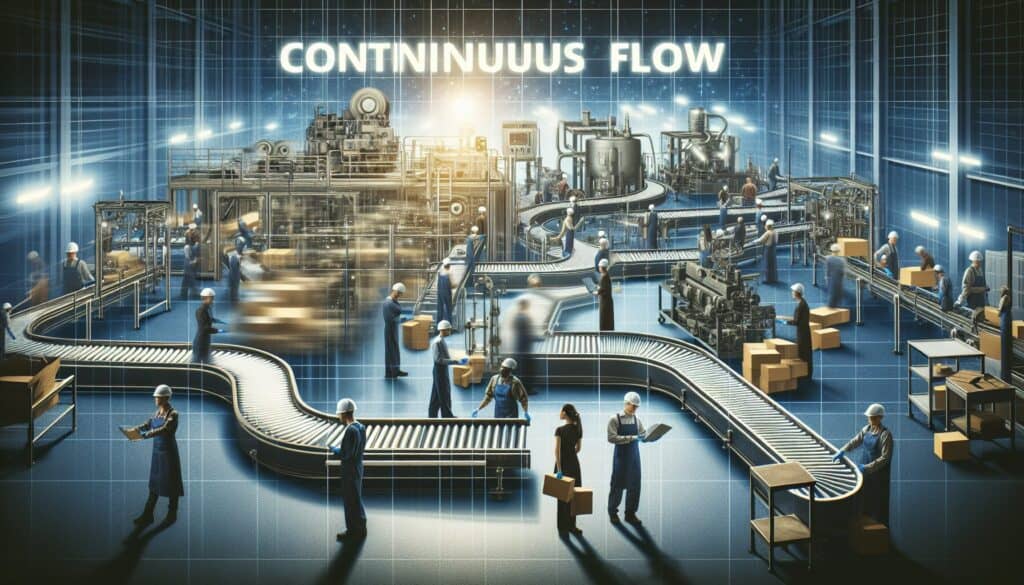实现在制品在生产系统中顺畅流动的状态,尽量减少中断、库存和等待时间。
- 方法: 工程, 质量
连续流

连续流
- 持续改进, 工业自动化, 准时制(JIT), 精益制造, 精益生产, 工艺优化, 生产效率, 质量控制, 质量管理
目标
如何使用
- 一种制造方法,产品从一个操作过程到下一个操作过程不间断地进行。它通常涉及专用生产线和高度自动化。
优点
- 生产率高、效率高;缩短交付周期,减少在制品库存;产品质量稳定;规模经济降低单位成本。
缺点
- 产品变更或定制的灵活性低;专业设备和设置的初始投资高;生产线的某个部分出现故障时,可能会出现严重的停机风险;如果需求不稳定,可能会出现生产过剩。
类别
- 精益西格玛, 制造业
最适合:
- 大批量、少品种的生产,效率和产量的一致性至关重要。
Continuous Flow methodology is particularly effective in industries such as automotive manufacturing, electronics, and consumer goods, where the demand for high-volume production with minimal variation is prevalent. In these settings, dedicated production lines facilitate the smooth transition of products from one stage to the next, allowing for streamlined operations that reduce downtime and enhance output. This approach is particularly suitable during the scale-up phase of a project when a company seeks to meet the demand without compromising on quality. Participants typically include process engineers, production managers, and supply chain experts who collaborate to optimize workflows and implement automation technologies like robotics and conveyor systems. One notable application of this methodology is in assembly lines for vehicles, where each component moves sequentially through stations that perform specific tasks. The efficiency gains can lead to reduced lead times and lower inventory levels, which not only decreases carrying costs but also mitigates the risk of obsolescence in fast-moving consumer goods. Lean manufacturing techniques are often integrated within Continuous Flow systems, enabling continuous improvement and waste reduction initiatives. As industries face increasing pressure to deliver products faster and at lower costs, Continuous Flow provides a robust framework for addressing these challenges, ensuring a consistent quality output that meets market demands.
该方法的关键步骤
- Design dedicated production lines for specific products.
- Implement automated systems for continuous material handling.
- Standardize work procedures to maintain process consistency.
- Monitor production flow in real-time for immediate adjustments.
- Conduct regular maintenance on equipment to minimize downtime.
- Employ Just-In-Time inventory practices to reduce excess stock.
- Utilize advanced forecasting tools for demand planning.
- Analyze production metrics continuously to identify improvement areas.
- Integrate feedback loops for constant product refinement.
- Train staff on new technologies and process improvements.
专业提示
- Implement advanced data analytics to monitor the real-time performance of each operation, allowing for proactive adjustments that optimize throughput.
- Utilize modular design principles to facilitate easier reconfigurations of production lines, accommodating changes in product designs or scaling operations effectively.
- Incorporate predictive maintenance strategies through IoT sensors, minimizing downtime by addressing potential equipment failures before they occur.
历史背景
1949
1950
1950
1960
1960
1960
1960
1940
1950
1950
1958
1960
1960
1960
1960
(如果日期不详或不相关,例如 "流体力学",则对其显著出现的时间作了四舍五入的估计)。















相关文章
制造运营管理(MOM)
制造执行系统(MES)
生产控制计划
人工测试
手动搬运评估表 (MAC)
手动任务风险评估工具(ManTRA)